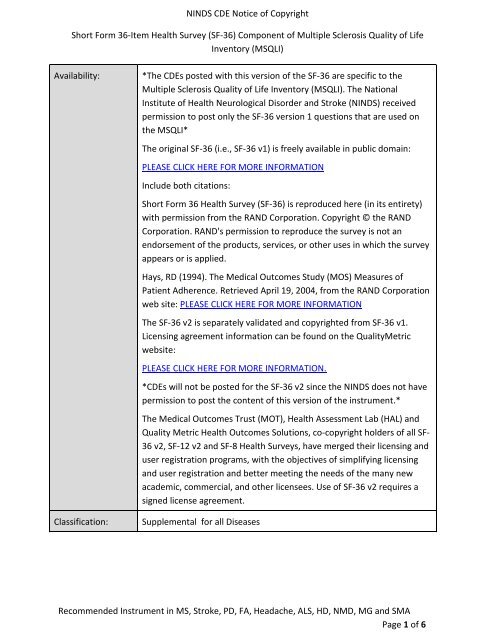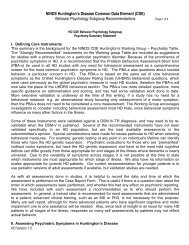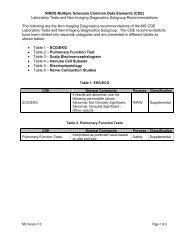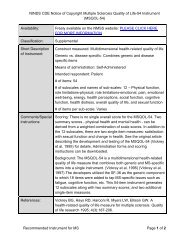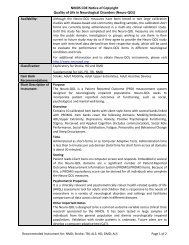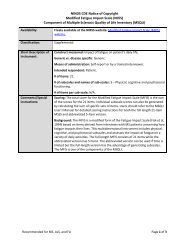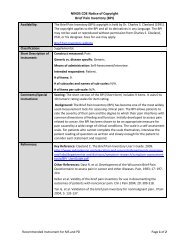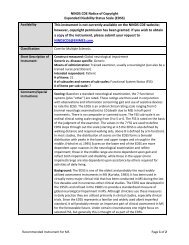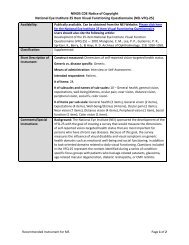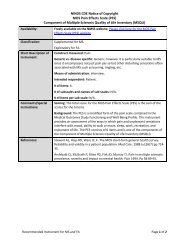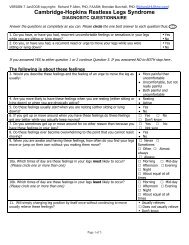Instrument Name: - NINDS Common Data Elements
Instrument Name: - NINDS Common Data Elements
Instrument Name: - NINDS Common Data Elements
Create successful ePaper yourself
Turn your PDF publications into a flip-book with our unique Google optimized e-Paper software.
<strong>NINDS</strong> CDE Notice of CopyrightShort Form 36-Item Health Survey (SF-36) Component of Multiple Sclerosis Quality of LifeInventory (MSQLI)Availability:*The CDEs posted with this version of the SF-36 are specific to theMultiple Sclerosis Quality of Life Inventory (MSQLI). The NationalInstitute of Health Neurological Disorder and Stroke (<strong>NINDS</strong>) receivedpermission to post only the SF-36 version 1 questions that are used onthe MSQLI*The original SF-36 (i.e., SF-36 v1) is freely available in public domain:PLEASE CLICK HERE FOR MORE INFORMATIONInclude both citations:Short Form 36 Health Survey (SF-36) is reproduced here (in its entirety)with permission from the RAND Corporation. Copyright © the RANDCorporation. RAND's permission to reproduce the survey is not anendorsement of the products, services, or other uses in which the surveyappears or is applied.Hays, RD (1994). The Medical Outcomes Study (MOS) Measures ofPatient Adherence. Retrieved April 19, 2004, from the RAND Corporationweb site: PLEASE CLICK HERE FOR MORE INFORMATIONThe SF-36 v2 is separately validated and copyrighted from SF-36 v1.Licensing agreement information can be found on the QualityMetricwebsite:PLEASE CLICK HERE FOR MORE INFORMATION.*CDEs will not be posted for the SF-36 v2 since the <strong>NINDS</strong> does not havepermission to post the content of this version of the instrument.*The Medical Outcomes Trust (MOT), Health Assessment Lab (HAL) andQuality Metric Health Outcomes Solutions, co-copyright holders of all SF-36 v2, SF-12 v2 and SF-8 Health Surveys, have merged their licensing anduser registration programs, with the objectives of simplifying licensingand user registration and better meeting the needs of the many newacademic, commercial, and other licensees. Use of SF-36 v2 requires asigned license agreement.Classification:Supplemental for all DiseasesRecommended <strong>Instrument</strong> in MS, Stroke, PD, FA, Headache, ALS, HD, NMD, MG and SMAPage 1 of 6
<strong>NINDS</strong> CDE Notice of CopyrightShort Form 36-Item Health Survey (SF-36) Component of Multiple Sclerosis Quality of LifeInventory (MSQLI)Short Description of<strong>Instrument</strong>:Construct measured: Health-related quality of lifeGeneric vs. disease specific: GenericMeans of administration: Interview or Self-AdministeredIntended respondent: Patient# of items: 36# of subscales and names of sub-scales: 8 – Physical Functioning, Role –Physical, Bodily Pain, General Health, Vitality, Social Functioning, Role-Emotional, Mental Health# of items per sub-scale: VariesRecommended <strong>Instrument</strong> in MS, Stroke, PD, FA, Headache, ALS, HD, NMD, MG and SMAPage 2 of 6
<strong>NINDS</strong> CDE Notice of CopyrightShort Form 36-Item Health Survey (SF-36) Component of Multiple Sclerosis Quality of LifeInventory (MSQLI)Comments/Specialinstructions:Scoring: The scoring system for the SF-36 is relatively complex andgenerates subscale scores for physical functioning, role limitations due tophysical problems, bodily pain, general health perceptions, vitality, socialfunctioning, role-limitations due to emotional problems, and mentalhealth. There is no single overall score for the SF-36, instead, It generates8 subscales and two summary scores. Two summary scores can also bederived from the SF-36: the physical component summary and themental component summary.Scoring corresponds to the use of the instrument. For SF-36 v1, scoringinstructions are publically available from the Rand Corporation (PLEASECLICK HERE FOR MORE INFORMATIONFor assessment of multiple sclerosis, question order varies from theoriginal version but content is included in the MSQLI and MSQOL-54instruments with additional content that must be presented and scoredto validate its use. Instructions and instruments for MS are publicallyavailable from the National Multiple Sclerosis Society (PLEASE CLICKHERE FOR MORE INFORMATIONRecommended <strong>Instrument</strong> in MS, Stroke, PD, FA, Headache, ALS, HD, NMD, MG and SMAPage 3 of 6
<strong>NINDS</strong> CDE Notice of CopyrightShort Form 36-Item Health Survey (SF-36) Component of Multiple Sclerosis Quality of LifeInventory (MSQLI)Rationale/Justification:Strengths/ Weaknesses:The SF-36 is easy to administer, covers a broad range of domains ofhealth-related quality of life, and is among the most widely used of suchmeasures. Availability of population-based normative data makes the SF-36 useful for comparative purposes. The availability of several subscalesmaybe useful to investigators interested in testing hypotheses concerningthese different areas of function.Psychometric Properties: In an MS population, the Cronbach's alphas forthe various subscales of the SF-36 range from .67 to .94. There isconsiderable evidence for the validity of the SF-36 in a variety ofpopulations including MS. (Vickrey et al, 1995) In Vickrey's study, thephysical functioning and role limitations due to physical problemssubscales were the ones that best discriminated between MS patientsand the normative U.S. population.data can be compared to the US normative population and acrossdisease states. To keep the instrument brief, some health statusconcepts are missing, e.g. family functioning, sexual functioning,cognitive functioning, sleep disorders. Suitable for self-administration,computerized administration or administration by a trained interviewerin person or by telephone.Administration: Administration time is approximately 10 minutes. TheSF-36 is a structured, self-report questionnaire that the patient cangenerally complete with little or no intervention from an interviewer.However, patients with visual or upper extremity impairments may needto have the SF-36 administered as an interview. Interviewers should betrained in basic interviewing skills and in the use of this instrument.Recommended <strong>Instrument</strong> in MS, Stroke, PD, FA, Headache, ALS, HD, NMD, MG and SMAPage 4 of 6
<strong>NINDS</strong> CDE Notice of CopyrightShort Form 36-Item Health Survey (SF-36) Component of Multiple Sclerosis Quality of LifeInventory (MSQLI)References:Hays, RD (1994). The Medical Outcomes Study (MOS) Measures ofPatient Adherence. Retrieved April 19, 2004, from the RAND Corporationweb site: PLEASE CLICK HERE FOR MORE INFORMATIONMcHorney CA, Ware JE, Raczek AE. The MOS 36-Item Short-Form HealthSurvey (SF-36®): II. psychometric and clinical tests of validity inmeasuring physical and mental health constructs. Med Care 1993;31(3):247-63.Ware, J.E., Kosinski M. SF-36 Physical and Mental Health SummaryScales: A Manual for Users of Version 1, Second Edition. Lincoln, RI:QualityMetric Incorporated, 2001.Ware J.E., Kosinski M., Dewey J.E. How to Score Version Two of the SF-36Health Survey. Lincoln, RI: Quality Metric, Incorporated, 2000.Ware JE, Kosinski M, Keller SK. SF-36® Physical and Mental HealthSummary Scales: A User's Manual. Boston, MA: The Health Institute,1994.Ware JE, Sherbourne CD. The MOS 36-Item Short-Form Health Survey(SF-36®): I. conceptual framework and item selection. Med Care 1992;30(6):473-83.Recommended <strong>Instrument</strong> in MS, Stroke, PD, FA, Headache, ALS, HD, NMD, MG and SMAPage 5 of 6
<strong>NINDS</strong> CDE Notice of CopyrightShort Form 36-Item Health Survey (SF-36) Component of Multiple Sclerosis Quality of LifeInventory (MSQLI)ReferencesStroke Specific:1Anderson C, Laubscher S, Burns R. Validation of the Short Form 36 (SF-36) health survey questionnaire among stroke patients. Stroke1996;27(10):1812-6.2Hobart JC, Williams LS, Moran K, Thompson AJ. Quality of lifemeasurement after stroke: uses and abuses of SF-36. Stroke2002;33:1348-56. Reference in text3Lai SM, Perera S, Duncan PW, Bode R. Physical and social functioningafter stroke: comparison of the Stroke Impact Scale and Short Form-36.Stroke. 2003;34:488–93.4O’Mahony PG, Rodgers H, Thomson RG, Dobson R, James OF. Is the SF-36 suitable for assessing health status of older stroke patients? AgeAgeing 1998;27(1):19-22.5Williams LS. Health-related quality of life outcomes in stroke.Neuroepidemiology. 1998;17:116–120.Huntingtons Disease Specific:1Ho A. K., Robbins A. O. G., Walters S. J., Kaptoge S., Sahakian B. J. &Barker R. A. Health-related quality of life in Huntington’s disease: acomparison of two generic instruments SF-36 and SIP. (2004).Movement Disorders 19(11), pp. 1341-1348.References 2Ho A. K., Stewart, A.S., Mason, S. L., Goodman, A. O. G. & Barker R. A.(2009). Health-related quality of life in Huntington’s disease: Whichfactors matter most? Movement Disorders 23(4):574-580.3Tabrizi SJ, Langbehn DR, Leavitt BR, et al. Biological and clinicalmanifestations of Huntington's disease in the longitudinal TRACK-HDstudy: cross-sectional analysis of baseline data. Lancet Neurol. Sep2009;8(9):791-801.4Tabrizi SJ, Scahill RI, Durr A, et al. Biological and clinical changes inpremanifest and early stage Huntington's disease in the TRACK-HD study:the 12-month longitudinal analysis. Lancet Neurol. Jan 2011;10(1):31-42.Recommended <strong>Instrument</strong> in MS, Stroke, PD, FA, Headache, ALS, HD, NMD, MG and SMAPage 6 of 6


